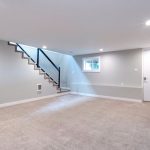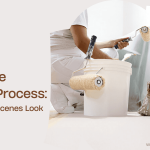If you’re considering a house painting project in Hobart, Tasmania, you’ve probably wondered when it’s safe to sleep in a freshly painted room. While a fresh coat of paint can breathe new life into your home, it’s essential to consider various factors that affect the safety and quality of your sleep after the paint job is done.
This article delves into the different aspects of painting your house and its impact on your ability to sleep comfortably.
The Type of Paint Matters
When planning your house painting project, one of the most critical decisions you’ll make is choosing the right type of paint. The type of paint you select can significantly affect the air quality in your home, especially in the hours and days immediately after the paint job is completed.
Water-Based Paint
Water-based or latex paint is the safer option for minimising paint fumes and ensuring a quicker return to normal living conditions. These paints have lower levels of VOCs, the primary culprits responsible for the strong odour and potential health risks associated with paint.
Oil-Based Paint
Oil-based paints, while durable and offering a smooth finish, release a higher concentration of VOCs compared to water-based paints. This means that rooms painted with oil-based paints will have a more potent and longer-lasting odour, making it less advisable for spaces where you plan to sleep shortly after painting.
Low-VOC Paint
For those concerned about indoor air quality, low-VOC or zero-VOC paints are a fantastic choice. These paints have significantly reduced levels of volatile organic compounds, making them an excellent option for bedrooms and other living spaces. They are environmentally friendly and emit minimal fumes, making them an ideal choice for anyone looking to sleep comfortably in a freshly painted room.
Ventilation Matters
Regardless of the type of paint you choose, it’s crucial to ensure proper ventilation during and after the painting process. Ventilation helps dissipate fumes and speeds up the drying process. Keep windows and doors open, use fans, and consider using an air purifier with a VOC filter to improve the air quality in your freshly painted room.
Hobart (Tasmania) VOC Laws

Hobart, the capital of Tasmania, is renowned for its stunning landscapes, beautiful homes, and vibrant culture. The city also takes environmental regulations seriously, including laws related to VOCs in paints. Understanding these regulations is essential when considering a house painting project in Hobart.
Tasmania follows the National Environmental Protection (Volatile Organic Compounds) Measure, which aims to limit the emission of VOCs from various sources, including paints. Under these regulations, there are specific limits on the VOC content of paints, and manufacturers must label their products with the VOC content information.
Before purchasing paint for house painting, check the label for compliance with these regulations. Look for paints that meet the recommended VOC limits, which will ensure your project is environmentally responsible and help you maintain a healthier indoor environment.
By using paints that adhere to Hobart’s VOC laws, you’ll be contributing to a greener, more sustainable future for your city while also reducing the potential risks associated with high VOC emissions.
How Long After Painting Can I Sleep in a Room?
Here are some general guidelines to help you determine when it’s safe to return to your bedroom:
Water-Based Paint
If you’ve used water-based paint for your project, you can typically return to your room within 2 to 4 hours. These paints have low VOC levels and dry faster, reducing the risk of inhaling harmful fumes. However, it’s still a good idea to keep the room well-ventilated for the first 24 hours.
Oil-Based Paint
Rooms painted with oil-based paint may take longer to dry and emit fumes. It’s best to wait at least 24 to 48 hours before sleeping in a room painted with oil-based products. Proper ventilation is crucial to speed up the drying process and reduce fume concentration.
Low-VOC Paint
With low-VOC or zero-VOC paints, you can often return to your room within 2 to 4 hours, similar to water-based paints. These paints are designed to be safer for indoor air quality and dry relatively quickly. However, as with any paint type, maintaining ventilation is essential.
The Extent of the Project
The size and scope of your house painting project can also influence the timeline. If you’ve painted just a small area or an accent wall, it may be safe to sleep in the room sooner. For larger projects that involve multiple rooms, waiting a bit longer is advisable, as the overall concentration of fumes will be higher.
Remember that while it may be safe to sleep in a freshly painted room after the recommended time has passed, it’s essential to ensure adequate ventilation during the initial days. This will help further reduce lingering odours and fumes, making for a more pleasant and comfortable living environment.
What Are The Harmful Effects of Breathing Paint Fumes While Sleeping?
Paint fumes are primarily made up of VOCs, which can have a range of adverse effects on your health. These effects can vary depending on factors such as the type of paint, the duration of exposure, and individual sensitivities. Here are some of the harmful effects to be aware of:
Effects of Paint Fumes on Children
Children are particularly vulnerable to the effects of paint fumes due to their developing respiratory systems and smaller lung capacity. Prolonged exposure to VOCs can lead to respiratory issues, irritate the eyes and throat, and cause headaches. It’s best to keep children out of freshly painted rooms until the paint has completely dried and the room has been adequately ventilated.
Effects of Paint Fumes on Pets
Pets can also be sensitive to paint fumes. Dogs and cats have a more acute sense of smell than humans, which can make the odour of fresh paint overwhelming for them. Inhaling paint fumes can cause pets to experience nausea, dizziness, and respiratory distress. If possible, it’s a good idea to relocate your pets to a well-ventilated area away from the painting project until the fumes have dissipated.
Effects of Paint Fumes on the Elderly
Elderly individuals may be more susceptible to the adverse effects of paint fumes due to age-related health issues. Inhaling paint fumes can exacerbate existing respiratory conditions, leading to breathing difficulties and discomfort. If you have elderly family members living with you, it’s essential to take extra precautions to ensure their comfort and well-being during and after the painting project.
Tips to Minimize the Risks Associated With Paint Fumes
Plan for Temporary Relocation
One of the most effective ways to minimise exposure to paint fumes is to plan for temporary relocation during the house painting process. This is particularly important for individuals with respiratory sensitivities. Staying in a hotel, with family or friends, or simply spending time outdoors can significantly reduce your exposure to paint fumes. If temporary relocation is not feasible, consider sealing off the painted area and focusing on proper ventilation.
Proper Ventilation
Using fans to circulate air can help expedite the dissipation of fumes. If you have an HVAC system, ensure it’s set to “vent” or “fan only” mode to help exhaust indoor air. Proper ventilation promotes a quicker drying time for the paint and ensures a healthier indoor environment.
Use Low-VOC or Zero-VOC Paints
Look for paints labelled “low-VOC” or “zero-VOC” and check for compliance with Hobart’s VOC regulations. Using environmentally friendly paint not only benefits your health but also contributes to a more sustainable and eco-conscious approach to house painting.
Keep Children and Pets Away
Children and pets are more vulnerable to the effects of paint fumes due to their smaller body sizes and developing respiratory systems. To protect their health, it’s essential to keep them away from freshly painted rooms until it’s safe to return. If temporary relocation is not possible, consider setting up a designated safe area where they can stay comfortably. Make sure this area is well-ventilated and free from paint fumes.
Monitor Elderly Family Members
Keep a close eye on any elderly family members living with you during and after the painting project. Ensure they have access to fresh air and are not directly exposed to the fumes. If necessary, consider arranging for temporary relocation to a safer environment.
Use Air Purifiers with VOC Filters
Place an air purifier in or near the freshly painted room, and let it run continuously for the first few days after the project is completed. This can help further reduce lingering odours and fumes, making the indoor air more breathable and comfortable.
Book a Free Consultation Now!
Trust Us for Safe and Effective House Painting in Hobart
Your home deserves the best, and we’re here to deliver excellence while prioritising your well-being. Our professional painters in Hobart are committed to using low-VOC and zero-VOC paints, adhering to all environmental regulations. We ensure proper ventilation during and after the painting process to minimise paint fumes.
Your family’s safety is our utmost concern, and we take extra care to protect children, pets, and the elderly from any potential harm. With over 50 years of experience, we’ve mastered the art of creating stunning, long-lasting finishes that are not only beautiful but also eco-friendly.
When you choose us for your house painting needs, you’re choosing a team that goes the extra mile to ensure a safe, comfortable, and aesthetically pleasing living space. Contact us at 0420-213-214 or email us at admin@dysonpainters.com.au to consult with our specialist painters in Hobart. Let’s transform your home into a work of art you’ll be proud of!





